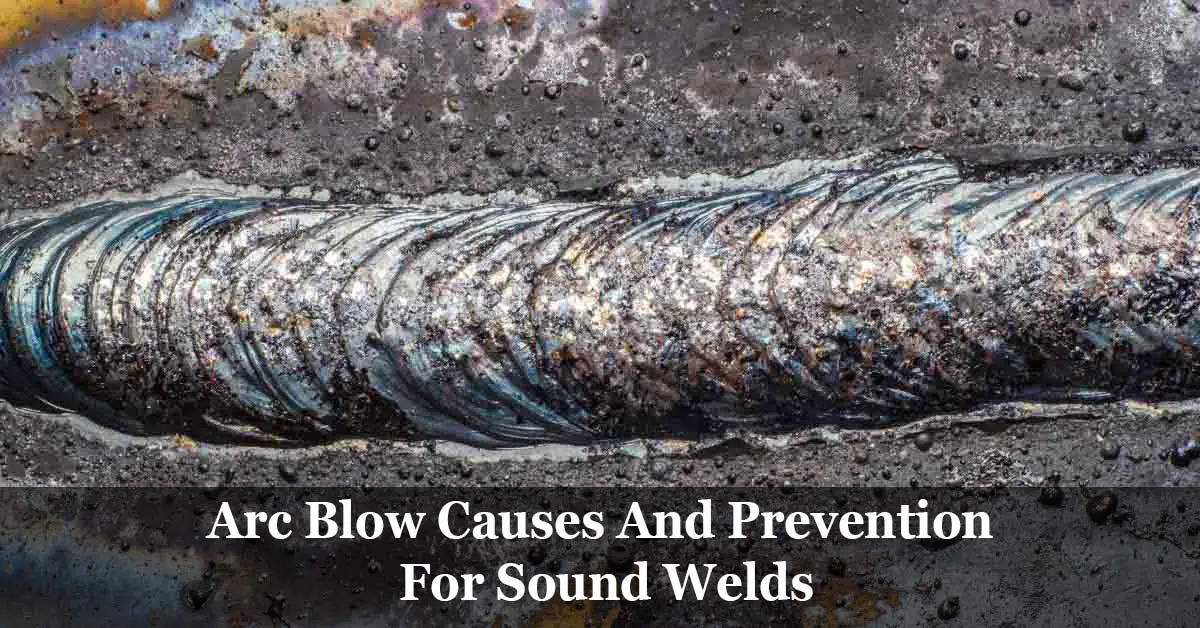Arc blow is known as when the molten metal during welding deviates from its usual path between the electrode and base metal (the standard path is the shortest distance between the electrode and base metal) and deflect to the forward or backward from welding travel direction or less commonly to the sides of welding direction. This deviation is caused by the unbalanced magnetic field surrounding welding arc on DC arc welding. Arc blow makes welder control of the molten pool difficult and subsequently causes various welding defects.
As the arc tends to blow either forward or backwards, forward blow and back blow are the arc blow types based on their direction. However, forward blow creates more difficulties to the welder as it tends to push the generated slag from the welding toward the forward or under the arc on which causes slag inclusion to be trapped in the weld.
Forward blow: occurs during welding at the start of the joint and during welding away from earthing connection. The forward blow may cause wide, wavy and irregular welding bead, intermittent undercut, and incomplete penetration.
Back blow: occurs during welding at the end of the joint, into the corners, and during welding toward earthing connection. The back blow may cause surface porosity, narrow and high welding bead, continuous or intermittent undercut, excessive penetration and spatters.
Magnetic and thermal are the two main types of arc blow that defined by their origin; however, magnetic arc blow is the one causes more troubles to the welder and therefore causes most of the welding issues and defects.
Magnetic Arc Blow
As previously mentioned, the magnetic arc blow is caused by unbalanced magnetic field surrounding welding arc on DC arc welding. Imbalance magnetic field exists due to change the direction of the current when it flows from the electrode to the base metal through the arc, and due to that, the arc is always at varying distance from the ground connection.
With experiments, magnetic arc blow issues frequently occur when welding with DC current in deep groove joints (mainly V joints) and at the corners of the workpiece using a high current. However, it was found the serious issues do not occur when using low current even when using DC current.
Switching to AC current reduces arc blow as AC current generates reversal magnetic field that reduces the strength of the main magnetic field which reduce the unbalanced magnetic field strength surrounding welding. As well, fit-up and workpiece geometry play an essential role in controlling magnetic arc blow problems and eliminating them.
Thermal Arc Blow
Defines as the tendency of the welding arc to lag behind due to reluctance of the arc to move to the colder zone during travelling, which is caused by the physic of the electric current and its tendency to move to hotter spot which is usually behind weld travelling direction.
Thermal arc welding cause negligible effect on manual welding; however, it has a considerable effect with higher speed automatic welding.
Multiwire welding is an example where we see the arc blow problems take place, the quick fix solution is by using both types of current, for example, DC + for the leading wire with AC for the trailing wire as this improves welding times and offsets the effects of arc blow. Double or multi-run welding techniques have direct effects on properties of both weld metal and the heat-affected zone; hence, all welding parameters should be considered on the approved WPS.
Welding defects caused by Arc Blow
Arc blow may cause various defects that can be summarized as follow:
- Wide, wavy and irregular welding bead or narrow and high welding bead depending on being forward or back blow.
- Continuous or intermittent undercut which is a depression at the toe of a weld in a previously deposited weld or base metal, and again it depends on arc blow type being forward or backwards.
- Incomplete or excessive penetration, which is welding penetration that either is not sufficient or exceeds the allowable limit.
- Surface porosity.
- Slag inclusion, slag inclusion due to arc blow may be located within the centre of a deposited weld, or between welds beads where it causes lack of inter-run fusion or at the sidewall of the weld preparation causing lack of sidewall fusion.
- Lack of fusion, which is a lack of union between two adjacent areas of material which is a severe defect that produces areas of high-stress concentration.
- Excessive spatters, spatters have no significant role in lowering weldments strength; however, it may mask other defects, may also hinder NDT and can also cause micro-cracking or hard spots in some materials.
Controlling Arc Blow
- Using DC with low current and shift to AC for higher current welding.
- Reduce welding travelling speed that requires a lower welding current.
- Perform demagnetization* process whenever it is practicality possible for the workpiece and post performing magnetic particle inspection (MPI).
- Performing the welding by a highly skilled welder that can keep the welding arc as short as possible with a proper angle of the electrode.
- Proper fit-up and fixturing of the workpiece using heavy tack weld and fixturing devices.
- Neutralizing the magnetic field of the workpiece by wrapping the ground cable around it.
* Demagnetization: Is the process to eliminate or reduce the magnetic moment in an object by randomizes the orientation of its magnetic dipoles, which is the reverse of magnetization. Demagnetization occurs naturally over time; however, it may be applied by heating the metal past the Curie point, applying alternating current, applying a strong magnetic field, or by hammering the metal.
The process is performed to avoid various welding defects that may occur due to the effect of Arc blow that caused by the magnetized workpiece, and for mechanical components that being magnetized may result in a malfunction or damage.
References:
- Lincoln Electric: The Procedure Handbook of Arc Welding.







